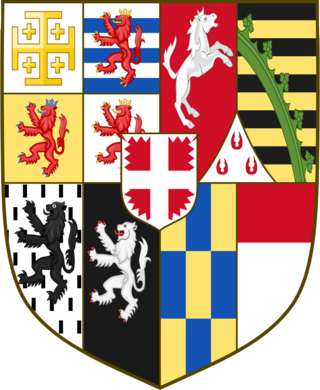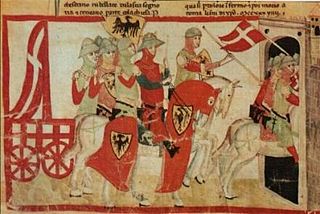
Year 1255 (MCCLV) was a common year starting on Friday of the Julian calendar.

Asti is a comune (municipality) of 74,348 inhabitants (1–1–2021) located in the Italian region of Piedmont, about 55 kilometres east of Turin, in the plain of the Tanaro River. It is the capital of the province of Asti and it is deemed to be the modern capital of Montferrat.

The House of Savoy-Carignano originated as a cadet branch of the House of Savoy. It was founded by Thomas Francis, Prince of Carignano (1596–1656), an Italian military commander who was the fifth son of Charles Emmanuel I, Duke of Savoy. His descendants were accepted as princes étrangers at the court of France, where some held prominent positions. Upon the extinction of the main Savoy line they eventually came to reign as kings of Sardinia from 1831 to 1861, and as kings of Italy from 1861 until the dynasty's deposition in 1946. The Savoy-Carignano family also, briefly, supplied a king each to Spain and Croatia, as well as queens consort to Bulgaria and Portugal.

The Guelphs and Ghibellines were factions supporting respectively the Pope and the Holy Roman Emperor in the Italian city-states of Central Italy and Northern Italy during the Middle Ages. During the 12th and 13th centuries, rivalry between these two parties dominated political life across medieval Italy. The struggle for power between the Papacy and the Holy Roman Empire arose with the Investiture Controversy, which began in 1075 and ended with the Concordat of Worms in 1122.

Alessandria is a city and commune in Piedmont, Italy, and the capital of the Province of Alessandria. It is also the largest municipality of the region. The city is sited on the alluvial plain between the Tanaro and the Bormida rivers, about 90 kilometres east of Turin.

The Battle of Cortenuova was fought on 27 November 1237 in the course of the Guelphs and Ghibellines Wars: in it, Holy Roman Emperor Frederick II defeated the Second Lombard League.
The siege of Faenza occurred from August 1240 to April 14, 1241, during the course of the wars of the Guelphs and the Ghibellines. In this military confrontation, the Holy Roman Emperor Frederick II aggressively laid siege to the town of Faenza and successfully captured the city.

The Battle of Parma was fought on 18 February 1248 between the forces of Holy Roman Emperor Frederick II and the Lombard League. The Guelphs attacked the Imperial camp when Frederick II was away. The Imperial forces were defeated and much of Frederick's treasure was lost.
Giordano d'Agliano, sometimes Giordano Lancia, was an Italian nobleman and military commander who served as marshal of the Kingdom of Sicily under King Manfred (1258–1266). He played a prominent role in the wars of the Guelphs and Ghibellines in Tuscany.
John II Palaeologus was the Margrave of Montferrat from 1338.

The Battle of Gamenario, fought on 22 April 1345, was a decisive battle of the wars between the Guelphs and Ghibellines. It took place in north-west Italy in what is now part of the commune of Santena about 15 km southeast of Turin.
William VII, called the Great Marquis, was the twelfth Marquis of Montferrat from 1253 to his death. He was also the titular King of Thessalonica.
William VI was the tenth Marquis of Montferrat from 1203 and titular King of Thessalonica from 1207.
Boniface II, called the Giant, was the eleventh Marquis of Montferrat from 1225 until his death. He became the titular King of Thessalonica in 1239.

Some events which occurred in 1345 in Italy:

The flag of the Holy Roman Empire was not a national flag, but rather an imperial banner used by the Holy Roman Emperor; black and gold were used as the colours of the imperial banner, a black eagle on a golden background. After the late 13th or early 14th century, the claws and beak of the eagle were coloured red. From the early 15th century, a double-headed eagle was used.
The Battle of Roccavione was the last battle of the invasion of the territory of Asti by Angevine troops from the Kingdom of Sicily. Charles I of Sicily was defeated, and his entire invasion failed. The battle was also the end of the Astigiani participation in the wars of the Guelphs and Ghibellines, and the end of Charles' intervention in the rest of the Italian Peninsula.

Torino Lingotto railway station is one of the main stations serving the city and comune of Turin, capital of the region of Piedmont, northwestern Italy. The Torino Lingotto metro station is located nearby, and opened on March 6, 2011.
Ottone del Carretto, a patron of troubadours and an imperialist, was the margrave of Savona (c.1185–91) and podestà of the Republic of Genoa (1194–95) and of Asti (1212). He was the founder of the Del Carretto family.
Manfred IILancia or Lança, was the eldest son of Manfred I and nominally margrave of Busca. He became an Imperial Vicar and a faithful follower of Frederick II.











